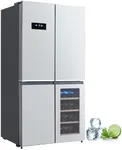Buying Guide for the Best Rated Refrigerators
Choosing the right refrigerator can significantly impact your daily life, from keeping your food fresh to saving on energy bills. When selecting a refrigerator, it's essential to consider various factors to ensure it meets your needs and fits well in your kitchen. Here are some key specifications to help you make an informed decision.CapacityCapacity refers to the total storage space available inside the refrigerator, usually measured in liters or cubic feet. This spec is crucial because it determines how much food and drink you can store. For small households or individuals, a refrigerator with a capacity of 200-300 liters might be sufficient. Medium-sized families may need 300-500 liters, while larger families or those who buy in bulk might require 500 liters or more. Consider your shopping habits and the number of people in your household to choose the right capacity.
Energy EfficiencyEnergy efficiency indicates how much electricity the refrigerator uses. This is important because it affects your energy bills and environmental footprint. Refrigerators are often rated with stars or labels indicating their efficiency. More stars or higher ratings mean better efficiency. Look for models with higher energy efficiency ratings to save on electricity costs and reduce your environmental impact. If you use your refrigerator frequently or live in a hot climate, prioritizing energy efficiency is even more critical.
TypeRefrigerators come in various types, including top-freezer, bottom-freezer, side-by-side, and French door models. The type affects the layout and accessibility of the fridge and freezer compartments. Top-freezer models are typically more affordable and offer ample freezer space. Bottom-freezer models make it easier to access fresh food. Side-by-side models provide equal access to both fridge and freezer sections, while French door models offer a combination of style and convenience with wide shelves and more flexible storage options. Choose the type that best fits your kitchen layout and how you prefer to access your food.
DimensionsDimensions refer to the physical size of the refrigerator, including height, width, and depth. This spec is essential to ensure the refrigerator fits in your kitchen space. Measure the area where you plan to place the refrigerator, including any clearance needed for doors to open fully. Standard refrigerators range from 30 to 36 inches in width, but compact models can be narrower. Make sure to account for ventilation space around the unit as well. Choose a refrigerator that fits comfortably in your kitchen without obstructing movement or other appliances.
FeaturesModern refrigerators come with various features that can enhance convenience and functionality. Common features include adjustable shelves, humidity-controlled crisper drawers, ice and water dispensers, smart connectivity, and temperature control zones. These features can make it easier to organize and access your food, maintain optimal freshness, and even control the refrigerator remotely. Consider which features are most important to you based on your lifestyle and preferences. For example, if you frequently entertain guests, an ice and water dispenser might be valuable, while smart connectivity could be useful for tech-savvy users.
Noise LevelNoise level refers to how loud the refrigerator operates, typically measured in decibels (dB). This spec is important if your kitchen is close to living or sleeping areas, as a noisy refrigerator can be disruptive. Most modern refrigerators operate at a noise level between 30-50 dB. Quieter models are preferable for open-plan homes or if you are sensitive to noise. If noise is a concern, look for refrigerators with lower dB ratings or those specifically marketed as quiet models.





















